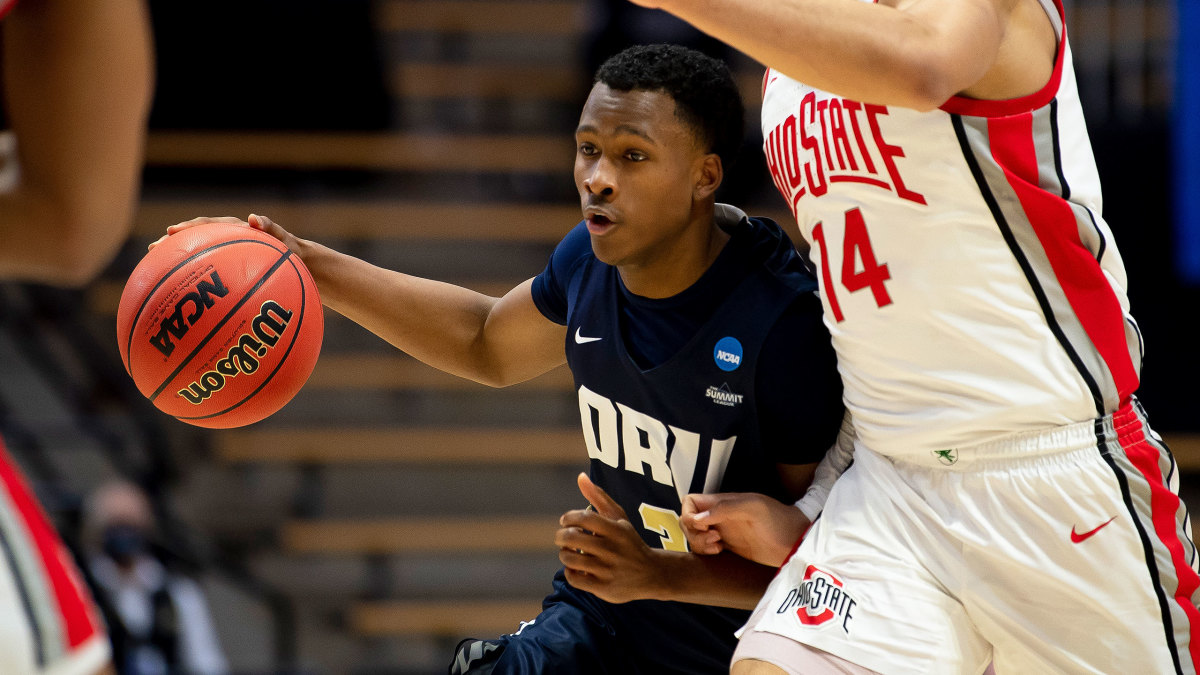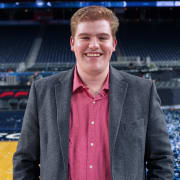After Years of Being Overlooked, All Eyes Are on Oral Roberts's Max Abmas
The legend of Max Abmas begins long before he was draining threes from just inside of halfcourt in the men's NCAA tournament for Oral Roberts.
One story that sticks out in the mind of Abmas’s AAU coach Kevin Butler, dates all the way back to his ninth-grade summer. While playing at the Nike Peach Jam in Atlanta, Abmas scored 47 points against a team from Chicago that featured multiple future high-level Division I players. Abmas’s team lost by two points, but his opponents were so floored by the performance that they came over and asked Max for his autograph.
“That was wild,” Butler recalls.
There are too many stories like that for Butler to count. There was the time Abmas, as a 13-year-old, played in a 17U AAU game in Duncansville, Texas, and dropped 38 points. Or when he went toe-to-toe with No. 1 point guard recruit Cole Anthony at the Fab 48 tournament in Las Vegas with well over 100 college coaches in attendance.
Abmas won’t even turn 20 until next week. He led the country in scoring this season. He’s the third player in the last 30 years to average at least 24 points, shoot 40% from three and 50% from two in his first or second year of college. The other two? Kevin Durant and Stephen Curry. Florida head coach Mike White, in the moments after his team was torched for 26 points by Abmas, described Max as a “track athlete out there who shoots as well as any guard in the country.”
So how in the world did Abmas wind up at Oral Roberts and not, say, Florida? Or North Carolina or LSU, schools Max grew up watching? What about the dozens of other high-major schools sitting at home right now while Abmas leads ORU to the Sweet 16?
“None of the Power 5 conferences recruited him at all,” Butler says. “Max has done an exceptional job of proving everyone wrong.”

It’s not like those big programs never saw Abmas play. His AAU teammate Sam Freeman now plays at Minnesota and was recruited by the likes of Virginia Tech, TCU and Georgetown. Julius Marble, his high school teammate at Jesuit Dallas, was recruited by several high-majors before choosing Michigan State. Add in high-profile AAU events like the matchup against Anthony, and a lack of exposure wasn’t the issue.
The big problem, according to Butler, was Abmas didn’t pass the “eye test” for most college coaches. On his Oral Roberts roster bio, Abmas is listed at 6’ 1” and a slender 165 pounds. His Rivals recruiting profile measures him at 5’ 11” and 160 pounds. Some coaches questioned if he was really a point guard or more of a scorer.
“He wasn’t 6’ 6”, he wasn’t jumping out of the gym. But at the end of the day, Max has an uncanny ability to play basketball at a high level,” Butler says. “The object is for you to put the ball in the basket and your team to win, and we had great success with Max.”
According to Abmas's father Troy, Max was always one of the shortest players his age growing up. But Max learned to thrive despite often being the shortest player on the floor from battles against his brother, who is three years older than him.
“He had to improvise and make things happen based on his skillset,” Troy says.
A huge part of that skillset was always the three point shot. Butler said Abmas was a “exceptionally sharp” shooter from the time he first started coaching him in fifth grade.
“He has always been a smaller kid, but his ability to put the ball in the basket was second to none,” Butler says.
With that shot-making ability grew incredible confidence. Now nicknamed “Midcourt Max” because of his limitless shooting range and willingness to fire from anywhere on the court, Abmas seems to believe he’ll make any shot he takes.
“Max has all the confidence in the world,” Butler says. “We always encouraged him to shoot the basketball two, three steps in from halfcourt.”
Despite all the highlights, the interest from high-level programs never came. Other than Oral Roberts, the only programs to offer Abmas were Army, Navy and Air Force. Butler also said Abmas had interest from Ivy League programs. Perhaps that’s no surprise: Abmas carries a 3.69 GPA at ORU while majoring in biomedical chemistry.
“If he was ever frustrated [by the lack of interest], he never said it,” Troy Abmas says. “He just used it as fuel to get better.”
Once Abmas arrived at Oral Roberts, his game took off. He got stronger, sped up the release on his jumper, and got comfortable playing at the fast pace Oral Roberts likes to play at. With that has come the accolades: Summit League Player of the Year, the nation’s leading scorer, and now two NCAA tournament wins, all in his first two years of college. His parents didn’t even see this type of rise coming.
“I knew he was a shooter, and I knew he could contribute, but I didn’t think he’d be leading the nation in scoring as a sophomore,” Troy Abmas says. “He probably didn’t think so either.”
Now, after years of being overlooked and dismissed as too small, the basketball world’s eyes are all on Abmas. And after scoring 55 points in his first two NCAA tournament games, Abmas’s next challenge might be proving to NBA scouts the same thing he proved at the college level: Despite his height, he can play with anyone.
“People won’t forget the school Oral Roberts and they won’t forget the name Max Abmas after this thing is all said and done,” Butler says. “He has positioned himself to play at the next level.”
SI’s tournament newsletter analyzes everything you need to know about the Big Dance: what just happened and what’s happening next. Sign up for Morning Madness here.
